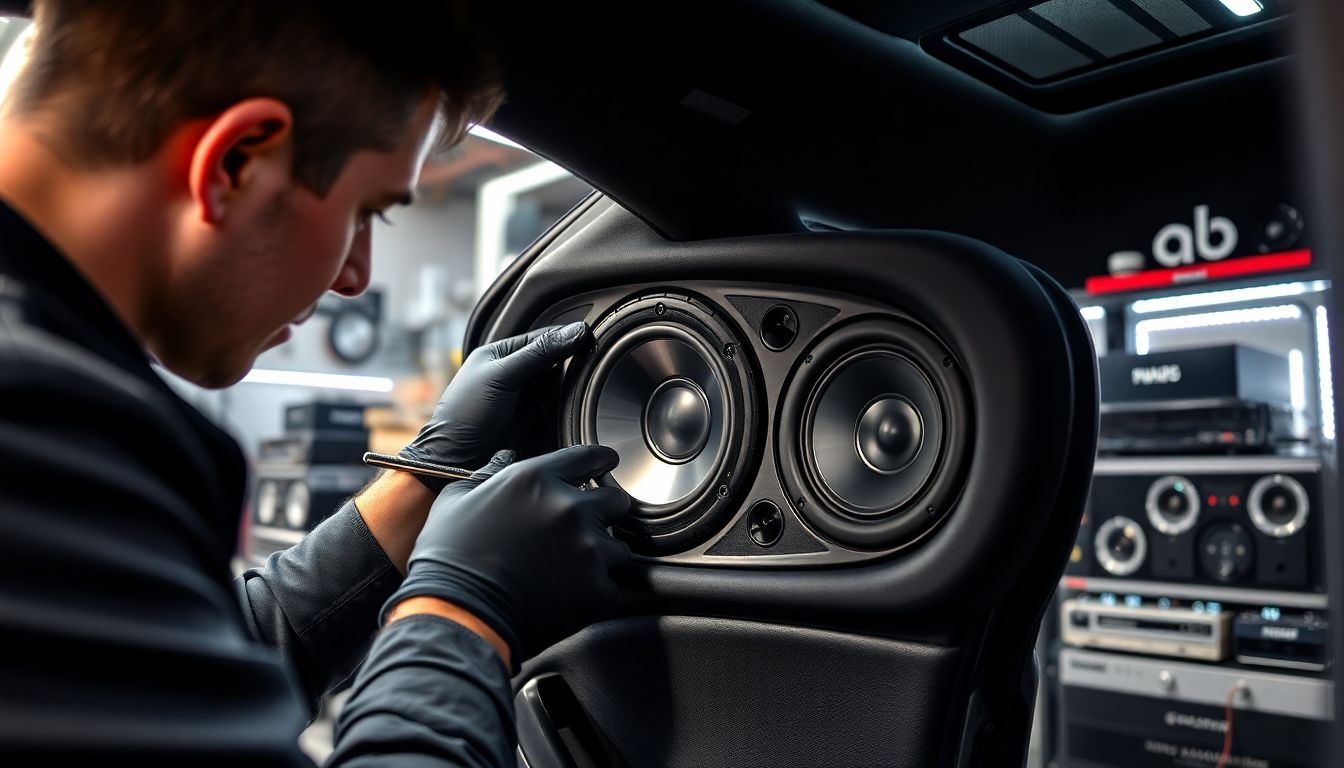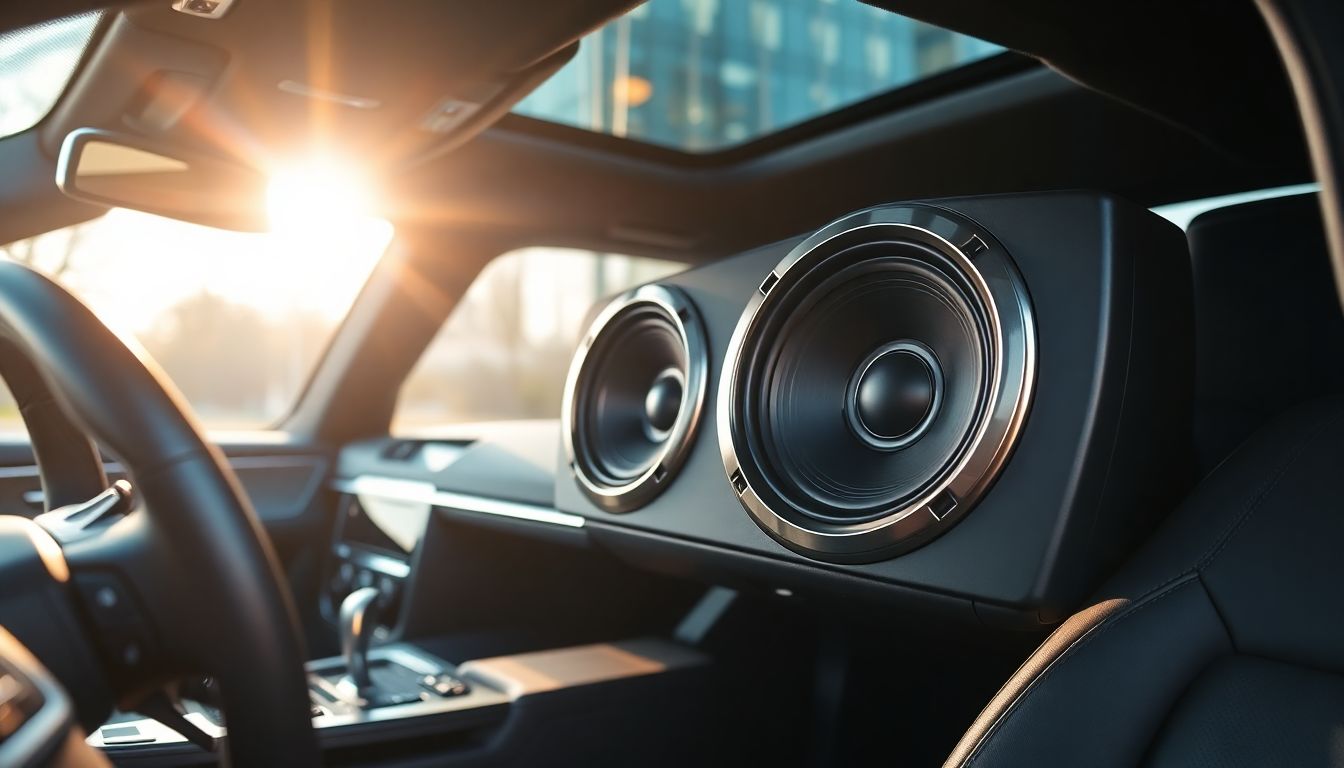

Sound quality in your car can make every trip feel like a concert. When you choose high-quality speakers, your music sounds clearer, with punchy bass and bright vocals. Poor speakers turn your favorite playlist into noise, ruining the ride. Finding the right speakers isn’t just about price; it’s about making wise choices that match your music habits. This guide helps you understand what to look for to pick the best car speakers for your vehicle.
Understanding the Basics of Car Speakers
Types of Car Speakers and Their Roles
Car speakers come in different types, each designed to handle a specific part of the sound. Coaxial speakers combine multiple speaker elements in one unit, making installation simple and cost-efficient. Component speakers separate the tweeters and woofers, providing better clarity. Subwoofers focus only on deep bass, giving your music more power. Tweeters are small speakers that handle high frequencies, adding detail to vocals and instruments. Knowing how each type works helps you assemble a system that sounds balanced and crisp.
How Car Speakers Affect Sound Quality
Good speakers produce more transparent sound, richer bass, and detailed highs. Low-quality or mismatched speakers can cause distortion, weak bass, or uneven sound. Music will sound hollow or muffled if your speaker isn’t powerful enough. On the other hand, mismatched speakers may strain your amplifier, leading to blown components. Choosing the right speakers ensures your audio stays sharp, vibrant, and distortion-free.
Key Terminology in Car Audio
- Power Handling: The maximum power a speaker can handle without damage.
- Sensitivity: How loud a speaker gets with a certain amount of power.
- Impedance: Resistance to electrical current, usually measured in ohms.
- Frequency Response: The Range of sounds a speaker can reproduce accurately.
Understanding these terms means you can pick speakers that work well with your current system and avoid costly mistakes.
Factors to Consider When Choosing Car Speakers
Size and Compatibility
Car doors and dashboards have limited space. Before buying, measure the exact size of your current speakers. Standard sizes include 6.5 inches, 6×9 inches, or 4 inches. Make sure new speakers fit without modifications. Check your vehicle’s manual or speak to an expert to avoid buying mismatched gear.
Sound Quality and Performance
Prioritize speakers that offer a broad frequency response for a more complete sound. Clear vocals and tight bass are key indicators of quality. For example, high-quality speakers will produce deep bass without overwhelming the vocals. Low-quality options might sound tinny or muddy. Listening to demos helps you compare sound clarity directly.
Power Handling and Sensitivity
Match the speaker’s power rating with your amplifier. Overloading a speaker can cause damage, while underpowering it might result in weak sound. Higher sensitivity means louder sound with less power, which is great for smaller amplifiers. Think of it like how much usable volume you get per watt of power.
Material and Build Quality
Speaker cones are made from materials like paper, polypropylene, or metal. Paper cones are light and produce a warm sound, while metal ones last longer and handle higher power. The frame and surround also matter; sturdy materials resist damage from heat and vibration. Better build quality leads to longer-lasting speakers that perform well over time.
Budget and Cost-Effectiveness
You don’t have to spend a fortune to get solid sound. Balance your budget with the features you need. Mid-range speakers offer excellent value for everyday use. For audiophile quality, expect to invest more. Remember, a good pair of speakers can last for years if chosen wisely.
How to Choose the Right Car Speakers for Your Needs
Assessing Your Listening Preferences
Do you love deep bass or clear vocals? Are you primarily using your car for commutes or serious listening? If bass is your priority, consider adding a subwoofer. For crisp highs, look for speakers with good tweeters. Consider what you want your music to sound like and choose speakers matching those goals.
Consulting Expert Opinions and Reviews
Read reviews from other buyers. Many trusted brands like Pioneer, JBL, and Kenwood have reputations for quality. Consumer reviews reveal how speakers perform in real-world conditions. Audio expert test results can also guide your choices, showing which models excel in clarity and durability.
Testing and Comparing Speakers
Whenever possible, listen to speakers in person. Bring your favorite music to demo stores or listen to online demos. Ask store staff to play different models so you can compare sound quality side by side. Trust your ears—what sounds good to you is what matters most.
Installation Considerations
Decide if you’ll install the speakers yourself or hire a pro. Proper wiring and placement are essential for top sound. Incorrect installation can cause rattling or a weak sound. If unsure, professional installation ensures everything is tuned correctly for optimal performance.
Upgrading Your Existing System
Not all upgrades require a full system change. If your current speakers sound dull or distorted, replacing them is a good first step. Make sure new speakers are compatible with your current head unit and amplifier. Upgrading can significantly improve your listening experience without extensive work.
Installation and Maintenance Tips for Longevity and Optimal Performance
Proper Installation Techniques
Connect wires securely and avoid loose connections. Seal edges with weatherproof foam to prevent vibrations. Place speakers at ear level for better sound. Avoid installing in spots where dust or moisture can damage them. Good installation preserves sound quality and extends the life of your gear.
Regular Maintenance and Care
Clean speakers regularly to remove dust and debris. Use a soft cloth and avoid harsh chemicals. Look for tears or cracks in the cone. Address small issues early to prevent bigger problems later. Caring for your speakers ensures they keep sounding great for years.
Troubleshooting Common Issues
Distortion or rattling? Check for loose screws or debris. If sound suddenly drops or becomes muffled, examine wiring or connections. A burning smell or buzzing noise signals something is wrong—consider professional help. Maintaining your system avoids costly repairs and keeps your music playing smoothly.
Conclusion
Choosing the perfect car speakers begins with understanding your needs and the basics of sound technology. Size, quality, and performance all matter when building an ideal system. Prioritize good sound over cheap options, and don’t forget professional installation for best results. When you try to research and choose carefully, every drive becomes a better experience. Make your vehicle a mobile concert hall—start shopping today with confidence.

The Best Car Coaxial Speakers: Unlock Superior Sound Quality on the Road
Introduction
A good car audio system makes every drive more enjoyable. Whether it’s your daily commute or a long road trip, clear sound transforms your experience. Coaxial speakers are a popular upgrade because they improve sound quality without taking up extra space. They are easy to install and deliver balanced sound, good bass, and clarity. Picking the right coaxial speakers can give your vehicle better audio performance and make your music sound richer. Ready to explore the best options? Let’s see how to choose the perfect coaxial speakers for your ride.
What Are Car Coaxial Speakers? An Essential Overview
Definition and Functionality
Coaxial speakers combine multiple drivers into one single unit. This typically includes a woofer for bass, a tweeter for high notes, and sometimes a midrange driver. They work together to produce a full sound spectrum from a single location. Unlike component systems that split drivers into separate units, coaxial speakers aim for a simple, space-saving design. They are designed to fit into your vehicle’s existing speaker openings effortlessly.
Benefits of Using Coaxial Speakers
- Space-efficient: They fit easily in most car doors or panels.
- Easy to install: No need for complicated wiring or mounting.
- Cost-effective: They offer good sound without breaking the bank.
- Sound balance: They deliver sound evenly across your vehicle, ideal for daily use.
Limitations to Consider
- For audiophiles seeking high-fidelity sound, coaxial speakers may fall short.
- They don’t provide the same detailed sound staging as component systems.
- Placement of speakers can limit sound positioning, affecting the overall experience.
Key Factors to Consider When Choosing the Best Car Coaxial Speakers
Power Handling and Sensitivity
Before buying, check your car stereo’s output. Do the best speakers match well? Look at these specs:
- RMS Power: How much continuous power the speaker can handle without damage.
- Peak Power: The maximum power the speaker can take in short bursts.
- Sensitivity: Higher sensitivity means louder sound at lower power. Aim for at least 90 dB for most systems.
Size and Fitment
Common sizes include 6.5-inch and 6×9-inch speakers. Always measure your current openings before buying. Some speakers are larger and may require modification or different mounting brackets. Accurate measurements prevent returns and ensure a snug fit.
Sound Quality Characteristics
- Frequency Response: Ranges from low bass to high treble. A wider range offers richer sound.
- Cone Material: Better materials like polypropylene, rubber, or composite contribute to clear sound and durability.
- Design: A well-designed cone reduces distortion and improves bass.
Durability and Weather Resistance
Vehicles face different conditions. Rubber surrounds and waterproof coatings help speakers withstand rain, snow, and dust. Good weather-resistant speakers last longer and deliver consistent performance over time.
Price Range and Value
Budget options start around $50, offering decent sound. Premium models can cost over $200 but provide better clarity and power. Look for features that match your needs and see reviews to judge value for money.
Top Car Coaxial Speakers of 2025
Premium Picks
JL Audio C2-650X
This model is known for exceptional sound quality. It boasts a robust build and warm, balanced tones. Customers praise its durability and clear audio, making it perfect for audiophiles. The C2-650X features a fiber-reinforced plastic cone and a soft dome tweeter that handles high frequencies well.
Focal Integration CNS 690
Offering a balanced sound profile, this speaker excels with high-quality materials. It delivers detailed mids and crisp highs, suitable for music lovers who want clarity and depth. Its sturdy construction withstands daily use and harsh conditions.
Best Budget Coaxial Speakers
Pioneer TS-A1670F
A favorite for budget-conscious drivers, this speaker provides impressive sound for its low price. It features a multi-layered MICA matrix cone for durability and a balanced frequency response. Users report easy installation and good power handling.
Rockford Fosgate R165X3
Known for delivering solid sound and easy fitment, this model offers great value. It includes a textured polypropylene cone and a high-temperature voice coil. It’s ideal for those upgrading on a budget without sacrificing much sound quality.
Best for Bass-Heavy Audio
Kicker 43CSC654
If deep, punchy bass is your priority, this speaker delivers. It features a larger woofer cone that moves more air, producing richer low frequencies. Its tough rubber surround enhances bass response and durability.
Best for Clarity and High-Frequency Response
Infinity Reference REF-6520CX
This model is perfect if crisp mids and sparkling highs matter. Its responsive tweeter and durable cone produce detailed sound. Ideal for listening to music with complex vocals or intricate instrumentals.
Installation Tips and Common Challenges
Preparing Your Vehicle
Gather tools like screwdrivers, wire strippers, and a panel removal tool. Measure your current speakers to confirm fit before purchase. This step saves headaches later.
Step-by-Step Installation Guide
- Disconnect your vehicle’s battery to avoid shorts.
- Remove door panels or mounting covers.
- Carefully disconnect existing speakers.
- Mount your coaxial speakers securely into the existing openings.
- Connect wires properly, matching positive and negative terminals.
- Reassemble everything and test the sound.
Troubleshooting Common Issues
- No sound or low volume: Check wiring connections and ensure power is reaching the speakers.
- Distortion or rattling: Tighten mounting screws and avoid overdriving the speakers.
- Sound imbalance: Adjust your stereo’s equalizer for best clarity.
Enhancing Your Car Audio System with Coaxial Speakers
Complementary Upgrades
For even better sound, consider upgrading your amplifier or adding a subwoofer. This boosts power and enhances bass, making your listening richer and more immersive.
Acoustic Treatments and Soundproofing
Reducing outside noise with soundproof mats helps prevent sound distortion. This makes your coaxial speakers sound clearer and fuller.
Fine-Tuning Your System
Use equalizer settings to balance frequencies. Adjust treble for crispness, mids for clarity, and bass for depth. Small tweaks can make a big difference in sound quality.
Conclusion
Choosing the right coaxial speakers is key to upgrading your car’s audio. Focus on power handling, size, sound quality, and durability to match your vehicle and preferences. Reputable brands like JL Audio and Focal provide premium options, while Pioneer and Rockford Fosgate are great for budget buyers. Proper installation and complementary upgrades can turn your car into a concert hall on wheels. Start by evaluating your current setup, then pick speakers that fit your needs. The result? Better sound, happier drives, and music that feels just right.

Best Car Component Speakers: Ultimate Guide to Upgrading Your Vehicle’s Sound System
Introduction
A good sound system can transform your daily drive into a concert on wheels. It’s no secret—sharp, clear audio makes a huge difference on the road. Factory-installed speakers rarely deliver the sound quality most car lovers want. That’s when component speakers come into play. These speakers offer better clarity, power, and customization when compared to stock options. As more drivers seek premium audio, understanding the best car component speakers becomes essential for those aiming to upgrade their ride.
Understanding Car Component Speakers: What Sets Them Apart?
What Are Car Component Speakers?
Component speakers include separate drivers for different tones: tweeters for high notes, woofers for bass, and crossovers to manage sound flow. Unlike coaxial speakers—where everything is combined—these parts work on their own to produce richer, clearer sound. Think of them as a music band versus a solo performer; each element gets its own space to shine. Installing these allows better control over sound staging and quality.
Benefits of Using Component Speakers
The main perk? Sound clarity. With dedicated tweeters and woofers, you get crisper vocals and punchier bass. This setup also improves stereo separation, so music feels more natural and immersive. Plus, they often last longer since they’re built with durable materials and designed for tougher environments. And let’s not overlook aesthetics—sleek, quality speakers bring a cleaner look to your car’s interior.
Common Applications and Suitable Vehicles
Component speakers are perfect for car owners who crave superior sound—think luxury cars, custom builds, or those replacing tired factory equipment. They fit well in most vehicles, but size compatibility matters. From sedans to SUVs, these speakers can be tailored for your specific ride to ensure maximum performance.
Key Factors to Consider When Choosing Car Component Speakers
Sound Quality and Performance
Look for speakers with a broad frequency response—ideally from around 60Hz to 20kHz—to cover deep bass to high treble. Power handling is key too; check if your car’s head unit can supply enough wattage without distortion. A higher sensitivity rating helps your speakers produce louder sound at lower power.
Build Quality and Durability
Materials matter. Cones made from polypropylene, aluminum, or composite materials resist warping. Surrounded by rubber or foam, they can handle vibrations and weather conditions. It’s wise to pick speakers with UV protection or moisture resistance, especially if you’ll be using them in open areas or humid climates.
Size and Compatibility
Standard sizes tend to be 6.5-inch or 5.25-inch, but custom-fit options exist. Always measure your current openings before buying. Some vehicles require mounting adapters—so researching your model ensures the speakers will fit securely and deliver optimal sound.
Additional Features and Technology
Advanced car speakers may include crossovers with adjustable settings, allowing you to fine-tune the sound to your preference. Tweeter mounting options—like flush or surface mount—offer flexibility for installation. Features such as magnetic shielding prevent interference with your car’s electronics, and some models support bi-amping for extra power.
Top Car Component Speakers in the Market
Premium Speakers for Audiophiles
If audio perfection is your goal, brands like Focal, JL Audio, and Hertz set the bar high. Focal’s Utopia series boasts crystal-clear sound and unmatched build quality. JL Audio’s C3 series offers impressive bass and clarity, while Hertz’s Hi-Energy line delivers power-packed performance. These premium options often come with a higher price tag but are worth it for true sound lovers.
Best Value for Money
Looking for a balance between price and quality? Brands like JBL, Infinity, and Pioneer hit the sweet spot. JBL’s GTO series delivers punchy sound with durability in mind. Infinity’s Kappa line offers excellent clarity, and Pioneer’s TS series balances performance and affordability. Customer reviews consistently praise these for solid sound without breaking the bank.
Budget-Friendly Options
For those on a tight budget, brands such as Rockford Fosgate, Boss Audio, and Dual Electronics provide decent performance at lower prices. Don’t expect flagship quality, but these speakers can significantly upgrade your system without draining your wallet. Perfect for beginners or casual listeners who want a meaningful boost.
Expert Recommendations and Industry Insights
Audio experts often highlight the importance of matching your speakers correctly to your system. Consumer reports note that investing in reputable brands ensures durability over years. Long-term testing shows that high-quality components keep sounding great, even after heavy use.
Installation Tips and Troubleshooting
Proper Installation Techniques
Place speakers where they can project sound toward the driver’s ears. Mount tweeters at ear level if possible. Use quality wiring to prevent distortions. Don’t forget to set your crossovers properly—this makes a huge difference in sound clarity. Sound tuning with equalizers can also help you get the most from your upgraded system.
Common Issues and Solutions
Distorted sound? Check wiring connections and polarity. Low volume? Make sure the amplifier or head unit can deliver enough power. If speakers produce buzzing or rattling, ensure they’re mounted tightly and that debris isn’t interfering. Regular cleaning and adjustments prevent common problems.
Professional vs. DIY Installation
Installing component speakers yourself saves money but requires patience and some skills. If you’re unsure, consult a professional. Proper installation by experts can avoid damage and maximize performance, making that extra cost worth it.
Conclusion
Choosing the right car component speakers isn’t just about price; it’s about matching performance with your needs. High-quality speakers can give your vehicle a richer sound, sturdiness, and a sleek look. Whether you’re craving audiophile-grade clarity or just want a noticeable upgrade, knowing what to look for makes all the difference. Take your time, measure carefully, and don’t hesitate to seek expert help when needed. Your perfect sound system awaits—and it’s worth the effort. Hope this guide will help you find the best car speaker for your needs!



